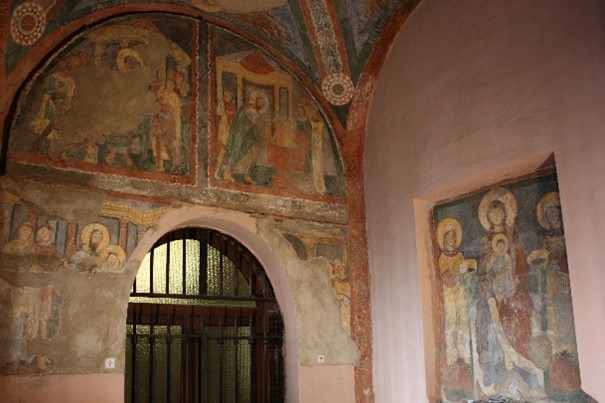The structure of the Basilica of Santa Pudenziana, by the will of Constantine, derives from the transformation into a place of worship of an ancient 2nd century thermal bath built on the ruins of the house of Senator Pudente who hosted the Apostles Peter and Paul, thus becoming a Domus Ecclesia "Domestic Church" with the Titulus Pastoris of 154 AD. Subsequently it was enlarged and known as Ecclesia Pudentiana, as written in the 5th century mosaic.
In the 16th century, Cardinal Caetani gave the church its current Baroque structure, building a vaulted roof that replaced the old wooden trussed roof.
He built an elliptical dome above the presbytery and transformed the two aisles into chapels, which were originally the walkways of the ancient baths around the basins that are currently located under the floor of the central nave.
Full ticket + 18 years € 10.00
Reduced ticket € 6.00
The visit includes: Guided tour of the Basilica, Access to the excavations and the Marian Oratory.
Visits on request: reservations for groups or requests for special visits write to incoming@orp.org
The site is a 10-minute walk from Termini Station:
The site is a 5-minute walk from the S. Maria Maggiore stop

Santa Pudenziana preserves the oldest of the great apsidal mosaics of Christianity dating back to 410-417 AD, and which served as a model for the Byzantine mosaics of the Pantocrator of the following centuries.

For the first time in tens of years, the Archaeological Excavations underneath the Basilica are accessible - although with a restriction to small guided groups - with the remains of the 1st century house of Pudente where Peter and Paul lived. A unique experience of immersion in ancient Rome!
Excavations of over 1000 square meters contain other testimonies up to the second century. B.C.
Among these finds, the remains of two floors of an ancient Roman Insula from the second century are worthy of note, with some of the rooms used as a shop on the ground floor
hide
Another jewel preserved in the premises of the Basilica is the ancient Marian Oratory, embellished with frescoes from the 11th-12th century. In particular, the fresco representing the baptism of Pudente's family by St. Peter.

In one of the side chapels Cardinal Enrico Caetani built his and his family's mausoleum, in particular of his brother Onorato, one of the leaders of the papal troops in the battle of Lepanto. The Caetani Chapel is one of the jewels of Baroque art in Rome
In addition to mosaics and a beautiful inlaid marble floor, the chapel is embellished with a Carrara marble high relief representing the Adoration of the Magi and dominates the altar.
hide